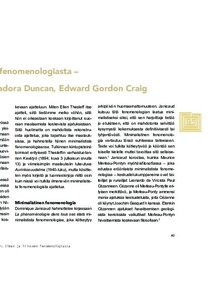Ilman ja liikkeen fenomenologiasta. Ellen Thesleff, Isadora Duncan, Gordon Craig.
Riikka Stewen
Ilman ja liikkeen fenomenologiasta. Ellen Thesleff, Isadora Duncan, Gordon Craig.
Riikka Stewen
Society for Art History
Julkaisun pysyvä osoite on:
https://urn.fi/URN:NBN:fi-fe2021042824852
https://urn.fi/URN:NBN:fi-fe2021042824852
Tiivistelmä
This article discusses Ellen Thesleff’s artistic practice and suggests that it is informed by a minimalistically phenomenological attitude. Minimalist phenomenology is a term introduced by Dominique Janicaud to describe artistic practices as translations of embodied perceptual experiences comparable to philosophical efforts to define experience. It is further suggested that air and gravity play an important role in her work. Her artistic thinking is also seen in connection with the artistic practice of dancer Isadora Duncan and theatre theorist Edward Gordon Craig. The role of antiquity as imagined in early 20th century modernism is reinterpreted as a phenomenological point de repère for these artists in their pathbreaking practices
Kokoelmat
- Rinnakkaistallenteet [27094]
